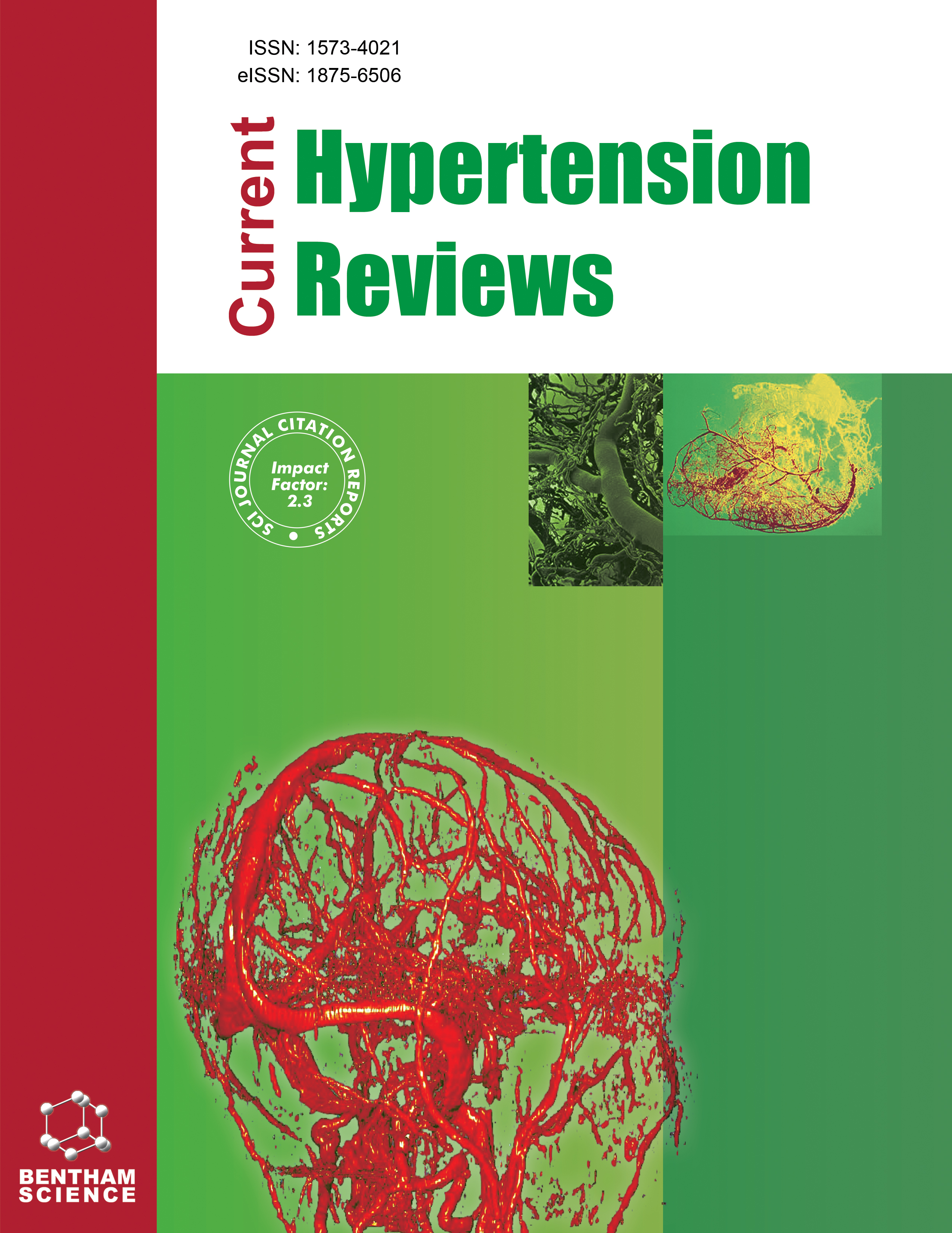- Home
- A-Z Publications
- Current Hypertension Reviews
- Previous Issues
- Volume 2, Issue 1, 2006
Current Hypertension Reviews - Volume 2, Issue 1, 2006
Volume 2, Issue 1, 2006
-
-
Blood Pressure and Cognitive Impairment in the Elderly
More LessAuthors: Giuseppe Bellelli, Angelo Bianchetti and Marco TrabucchiThe prevalence and incidence of dementias are expected to increase in the future. Accordingly, the identification of causes of dementia and of possible risk factors is very important. A large body of evidence has shown that hypertension is a risk factor for vascular dementia. Recently, it has been demonstrated that hypertension could affect the course of Alzheimer disease. A strong relationship between hypertension and cog Read More
-
-
-
Microalbuminuria In Primary Hypertension
More LessAuthors: Roberto Pontremoli, Francesca Viazzi, Giovanna Leoncini and Elena RattoMicroalbuminuria, i.e., abnormal urinary excretion of albumin detectable by sensitive, low cost, and widely available tests, can be found in up to one third of non diabetic patients with primary hypertension. Microalbuminuria has been shown to predict an increased probability of suffering a cardiovascular event or death. The pathogenetic mechanisms leading to the development of microalbuminuria are not yet fully known: Read More
-
-
-
The Resurgence of Aldosterone in Hypertension and Cardiovascular Disease
More LessAuthors: E. M. Freel and John M.C. ConnellAldosterone is a key cardiovascular hormone. Recent studies have illustrated its role in cardiac fibrosis and left ventricular hypertrophy as well as in impaired vascular reactivity. Moreover, many of these actions have been shown to be independent of its known effects on blood pressure. In a clinical setting, the benefits of aldosterone blockade in cardiovascular disease have been adequately demonstrated in recent large, rand Read More
-
-
-
Primary Hyperaldosteronism in the Hypertensive Disease
More LessAuthors: Carlos E. Fardella, Cristian A. Carvajal and Lorena M. MossoPrimary aldosteronism (PA) is one of the potentially curable forms of hypertension. The hypertension is secondary to aldosterone action in the kidney, reabsorbing sodium and water that increases the intravascular volume and blood pressure. PA was previously believed to account for less than 1% of hypertensive patients when hypokalemia is used as screening method. However, recent studies using the plasma aldosteron Read More
-
-
-
Usefulness of Home Blood Pressure in the Diagnosis and Control of Hypertension in Primary Care
More LessAuthors: Maria A Martinez and Juan G PuigSelf- measurement of blood pressure (BP) at home has gained increasing importance for the diagnostic and therapeutic evaluation of hypertensive patients. In comparison with clinic BP, self-measurement of BP with automated devices has several advantages: (1) higher reproducibility; (2) elimination of the "white coat effect" and observer bias; and (3) improvement of both compliance and BP control. Furthermore, there is Read More
-
-
-
PPARγ Agonists: Beneficial Effect on Blood Pressure Beyond Glycemic Control?
More LessAuthors: Panteleimon A. Sarafidis and Anastasios N. LasaridisThe Metabolic or Insulin Resistance Syndrome is a cluster of cardiovascular risk factors, such as type 2 diabetes mellitus, hypertension, central obesity, dyslipidaemia, and other disorders, which have been proposed to be secondary to insulin resistance. A number of possible mechanisms linking insulin resistance and compensatory hyperinsulinemia with hypertension have been described, such as renal sodium reabsorptio Read More
-
-
-
Transient Receptor Potential Channels, the Kidney and Hypertension
More LessBy Paolo MeneSmooth muscle cells as well as non-excitable cells express multiple cationic channels with variable selectivity for Ca2+, K+, Na+. Several of these channels are sensors of Ca2+ store depletion, G-protein-coupled receptor activation, membrane stretch, intracellular pH, oxidative stress, phospholipid signals and other factors. A novel family of such channels is represented by highly conserved heterotetramer homologues Read More
-
-
-
Ion Channel Architecture of the Renal Microcirculation
More LessAuthors: Malcolm R. Turner and Thomas L. PalloneVascular contraction is modulated, in part, by the cytoplasmic Ca2+ concentration in smooth muscle cells (SMCs). Ca2+ influx through voltage gated Ca2+ channels (VGCC) is governed by membrane potential. In turn, membrane potential is determined by the relative conductance of the membrane to various ions. Increase in Cl- conductance depolarizes SMCs to activate VGCC. K+ channel activation or inhibition can favor Read More
-
-
-
Effect of Ouabain on the Immune System
More LessAuthors: Juliana Echevarria-Lima and Vivian M. RumjanekImmune dysfunction has been reported in patients with hypertension and in spontaneously hypertensive rats. Increased circulating levels of ouabain were observed in experimental models and in human hypertension. Despite the correlation between immunologic depression and hypertension, the mechanisms involved are unclear. This review examines evidences of immune dysfunction in hypertension and presen Read More
-
Volumes & issues
-
Volume 21 (2025)
-
Volume 20 (2024)
-
Volume 19 (2023)
-
Volume 18 (2022)
-
Volume 17 (2021)
-
Volume 16 (2020)
-
Volume 15 (2019)
-
Volume 14 (2018)
-
Volume 13 (2017)
-
Volume 12 (2016)
-
Volume 11 (2015)
-
Volume 10 (2014)
-
Volume 9 (2013)
-
Volume 8 (2012)
-
Volume 7 (2011)
-
Volume 6 (2010)
-
Volume 5 (2009)
-
Volume 4 (2008)
-
Volume 3 (2007)
-
Volume 2 (2006)
-
Volume 1 (2005)
Most Read This Month
Article
content/journals/chyr
Journal
10
5
false
en


